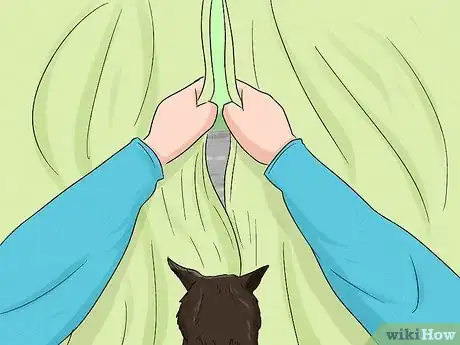This article was co-authored by Rita Reimers and by wikiHow staff writer, Hunter Rising. Rita Reimers is a Cat Behavior Expert and a Co-Founder of Cat Behavior Alliance, a cat behavior consulting service. With over 30 years of experience as a multi-cat owner and cat rescue worker, Rita specializes in helping people better understand cats and find solutions to behavior issues. She received a BS in Computer Science and Personnel Relations Management and studied at the Animal Behavior College. Rita co-hosts a radio show on Pet Life Radio, “19 Cats and Counting,” and co-hosts a YouTube series, “Let’s Talk Cats.” She is also the co-author of the cat behavior blog, “Kitty Korner” for Litter Genie. Rita also writes for “A New Cattitude” for Catster Magazine, and is a contributor to be.Chewy.com. She is a supporting member of the International Association of Animal Behaviorists (IAABC).
There are 16 references cited in this article, which can be found at the bottom of the page.
This article has been viewed 89,972 times.
Getting a new kitten can be an exciting part of your life, but a cat you already own may not warm up to it as quickly. It’s normal for cats to act territorial at first, but the fighting can sometimes get out of hand. If your cat bullies or attacks the kitten, there are a few things you can do to help them get comfortable around each other. If your cat still doesn’t leave your kitten alone, you may need to separate and slowly reintroduce them. While it can take a few weeks or months, hopefully your cat and kitten will learn to live happily together.
Steps
Eliminating Common Triggers
-
1Take your cat to a vet to check to rule out medical reasons for aggression. While your cat may just be acting territorial, it may also be uncomfortable and more prone to attack if it's sick. Schedule a visit with a veterinarian so they can run tests and check your cat for an underlying illness. If there’s a medical cause, the vet will prescribe medication to help relieve the cat’s pain.[1]
- Common diseases that cause aggression include hyperthyroidism, osteoarthritis, dental disease, and nervous system problems. If the cat is in pain, it probably won't be in the mood for playing with the kittens.
- If your cat doesn’t have any medical issues, then there may be territorial or environmental problems in your home.
-
2Provide each cat with its own food, litter, and toys. Try to provide enough bowls and litter for the number of cats you have plus 1 extra. Keep each of the bowls and litter in separate areas of your home so your cat and kitten can avoid each other while they’re eating or eliminating. On top of that, give each cat its own special set of toys to play with so they don’t have to compete for them.[2]
- For example, if you have 1 cat and 1 kitten, then try to spread 3 different food bowls throughout your home.
-
3Block areas where your cat normally hides before it attacks. Cats will sometimes pounce out from a hiding spot to play, but it can come across as aggressive to a new kitten. Put items in the empty space or put up a barrier so your cat can’t get into those areas anymore. Use objects that are irregularly shaped so your cat can’t easily perch on them or hide behind them.[3]
- For example, if your cat hides under your bed, you may store items around the outer edges so your cat can’t crawl underneath.
Warning: Don’t eliminate all hiding spots for your cat since they need somewhere to go when they feel stressed out.
-
4Restrict your cat’s view of outside if it attacks after seeing another animal. If your cat sees another animal outside, it may stress out and try to attack your kitten instead. Close the curtains or put up a solid barrier so your cat can’t see outside. Supervise your cat to make sure it doesn’t sneak behind the curtains or move them out of the way so it can still see. Otherwise, you may need heavier curtains or have to block out the window.[4]
- You can buy a textured stick-on film that attaches to your window to block your cat’s view without restricting how much light comes through the windows.
-
5Walk away if you notice your cat is anxious for your attention. Your cat may get jealous when you spend time with your new kitten, which can cause it to get aggressive near you. When your cat approaches you, check if it has dilated pupils, tense body posture, or a swishing tail. If it does, stand up and leave the room as soon as you can so your cat recognizes the behavior is unacceptable.[5]
- If you wait too long, your cat may get aroused enough to attack even after you leave the room.
-
6Have your cat spayed or neutered to tone down its aggression. Cats that are “intact” tend to have higher aggression than “fixed” animals since they have more hormones. Schedule an appointment with a veterinarian so they can spay or neuter your cat. Allow your cat to recover completely before you let it play with your kitten again.[6]
Reintroducing Your Cats
-
1Keep your cat in a separate room from the kitten. If you’re bringing home your kitten for the first time or if your cat constantly attacks the kitten, move them into different areas of your home so they can’t see each other. Provide separate food, water, litter, and toys for each cat so they don’t have to compete. Avoid letting your cats into the same room since they may get aggressive again.[9]
- It’s okay if your cats can hear or smell each other since it will help them get used to one another.
-
2Feed the cats on opposite sides of the same door. Set food bowls down so your kitten eats on one side of the door and your older cat eats on the other side. Even if the cats can’t see each other, they will get used to being around each other while they’re eating and won’t compete as much.[10]
- If your cats behave when they’re near the door, reward them with small treats.
-
3Introduce the cats face-to-face again after 1 week. Wait until your cats are calm, like after they eat a meal or play for a long time. Keep your kitten in a cage or carrier and allow your cat to come into the room. Let your cat explore around the cage freely while your kitten stays safely inside. As your cat and kitten get comfortable with one another, move the cage to a different room for another few days so your cat gets used to the kitten being around your home.[11]
- If your kitten gets scared or doesn’t seem calm, then try distracting it with food while the other cat explores the area.
-
4Let your cat and kitten interact when they are calm. Supervise your cats when you first let them interact to ensure they don’t start fighting. Open the cage and let your kitten roam freely near your adult cat to see how they act around one another. Reward your cats with treats if they behave and stay calm when they’re together.[12]
- If your cat starts attacking the kitten again, separate it from the kitten for another 1–2 days before trying to introduce them again.[13]
Variation: Consult with a veterinary behaviorist if your cat is still aggressive since it may need a prescription to calm it down. Behavioral prescriptions will not completely cure your cat and must be done in addition to environmental changes around the home.[14]
Breaking up a Fight
-
1Listen for hissing or screeching from either of your cats. It’s normal for your cat and kitten to play-fight with one another since it helps them bond. As long as your cats have time in between each bout of play-fighting, they’re okay and safe. However, if you notice your cat hissing, screeching, or baring its claws, then the playfulness may have escalated into a real fight.[15]
- If your cat has dilated pupils, whiskers out to the side of its face, and ears pulled backward, then it’s about to act aggressively.[16]
-
2Make a loud noise to get the cats’ attention. When you notice a fight, clap loudly, say your cat’s name, or hiss toward them so they stop. Don’t be so loud that you scare your cats since it will make them stressed and fearful of you in the future. Once you make a noise, your cats will turn their attention to you.[17]
- You can also try tossing a soft toy or towel in their direction if the loud noise doesn’t distract them.
Warning: Avoid breaking up the fight by hand or picking up your cat since it may act aggressively toward you by accident.
-
3Give your cats some space so they can calm down. While you may think punishing a cat discourages bad behavior, it can actually make your cat more fearful.[18] Instead, leave it alone and let it wander away from your kitten. Avoid trying to soothe your cat, since it may still act aggressively toward you.[19]
- If you do try to punish your cat, it may try to attack you when it gets defensive.
-
4Check your cats for any wounds. Once your cat and kitten are calm, run your hands through their fur and check for any injuries from the fight. Small scratches on the cat’s skin are safe, but look carefully for any deep claw or bite marks. If you notice any wounds, take your cat to a vet.[20]
- Deep wounds can heal on the surface, but trap bacteria inside and cause an infection.
Community Q&A
-
QuestionMy male cat chases my new male kitten, catches it and then bunny punches it with its back legs. Any advice?
 King GeorgeCommunity AnswerHave the cat and the kitten spend some time apart. They cat might think the kitten is an enemy.
King GeorgeCommunity AnswerHave the cat and the kitten spend some time apart. They cat might think the kitten is an enemy.
Warnings
References
- ↑ https://www.vet.cornell.edu/departments-centers-and-institutes/cornell-feline-health-center/health-information/feline-health-topics/feline-behavior-problems-aggression
- ↑ https://www.paws.org/resources/introducing-cat-to-cat/
- ↑ https://www.vet.cornell.edu/departments-centers-and-institutes/cornell-feline-health-center/health-information/feline-health-topics/feline-behavior-problems-aggression
- ↑ https://resources.bestfriends.org/article/cat-aggression-toward-other-cats-steps-changing-aggressive-feline-behavior
- ↑ https://resources.bestfriends.org/article/cat-aggression-toward-other-cats-steps-changing-aggressive-feline-behavior
- ↑ https://www.paws.org/resources/aggression/
- ↑ https://www.dvm360.com/view/new-advice-on-sterilizing-kittens-earlier-is-better
- ↑ https://icatcare.org/advice/aggression-between-cats/
- ↑ https://www.paws.org/resources/introducing-cat-to-cat/
- ↑ https://www.animalhumanesociety.org/behavior/adding-second-cat-your-household
- ↑ https://resources.bestfriends.org/article/introducing-new-cat
- ↑ https://www.paws.org/resources/introducing-cat-to-cat/
- ↑ https://www.paws.org/resources/aggression/
- ↑ https://www.vet.cornell.edu/departments-centers-and-institutes/cornell-feline-health-center/health-information/feline-health-topics/feline-behavior-problems-aggression
- ↑ https://resources.bestfriends.org/article/how-stop-cats-fighting
- ↑ https://www.vet.cornell.edu/departments-centers-and-institutes/cornell-feline-health-center/health-information/feline-health-topics/feline-behavior-problems-aggression
- ↑ https://www.paws.org/resources/aggression/
- ↑ https://www.paws.org/resources/aggression/
- ↑ https://www.aspca.org/pet-care/cat-care/common-cat-behavior-issues/aggression-between-cats-your-household
- ↑ https://icatcare.org/advice/aggression-between-cats/
- ↑ https://icatcare.org/advice/aggression-between-cats/
- ↑ https://icatcare.org/advice/aggression-between-cats/
- ↑ https://www.aspca.org/pet-care/cat-care/common-cat-behavior-issues/aggression-between-cats-your-household








































































